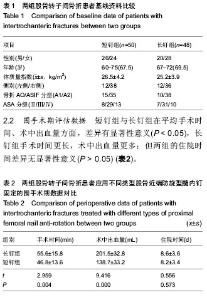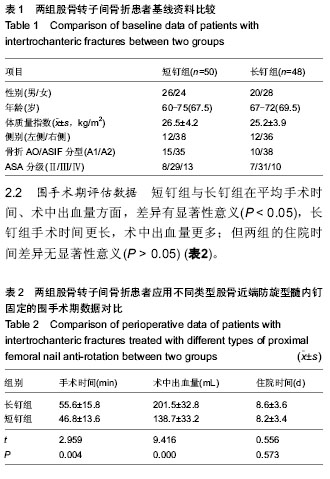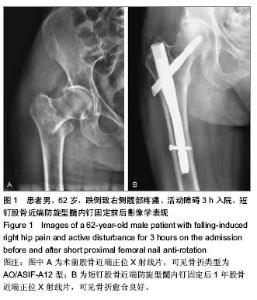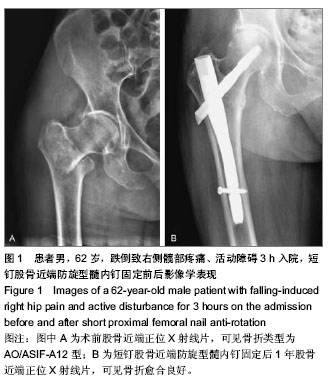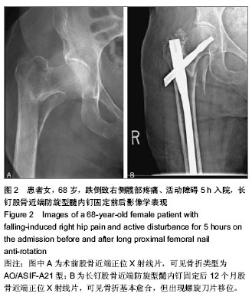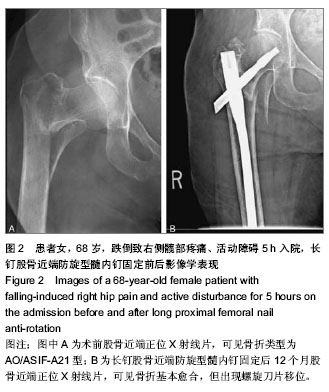Chinese Journal of Tissue Engineering Research ›› 2014, Vol. 18 ›› Issue (4): 595-600.doi: 10.3969/j.issn.2095-4344.2014.04.018
Previous Articles Next Articles
Long versus short proximal femoral nail antirotation in treatment of intertrochanteric fractures
Chen Xing-hua, Liu Tao, Huang Zhen-gu
- Department of Orthopedics, Dazu District People’s Hospital, Chongqing 402360, China
-
Revised:2013-10-07Online:2014-01-22Published:2014-01-22 -
Contact:Huang Zhen-gu, Associate chief physician, Department of Orthopedics, Dazu District People’s Hospital, Chongqing 402360, China -
About author:Chen Xing-hua, Department of Orthopedics, Dazu District People’s Hospital, Chongqing 402360, China
CLC Number:
Cite this article
Chen Xing-hua, Liu Tao, Huang Zhen-gu. Long versus short proximal femoral nail antirotation in treatment of intertrochanteric fractures[J]. Chinese Journal of Tissue Engineering Research, 2014, 18(4): 595-600.
share this article
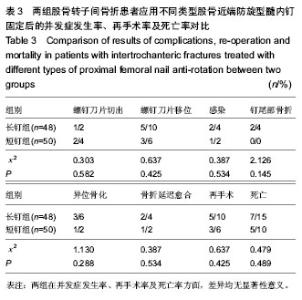
2.3 临床评估数据 两组所有患者均获得1年以上的临床及影像学随访,长钉组与短钉组的平均随访时间分别为(15.8±6.4)个月和(16.2±5.7)个月,组间差异无显著性意义(t=0.327,P=0.744)。 患者因螺旋刀片切出或感染而再次实施手术的患者长钉组中有5例,短钉组中有3例,除上述再手术患者之外,两组其余所有患者至末次随访时骨折均获得愈合,平均骨折愈合时间分别为(3.8±2.4)个月和(4.1±2.8)个月,组间差异无显著性意义(t=0.543,P=0.588)。至末次随访时,长钉组中7例患者死亡,短钉组中5例患者死亡,除了死亡患者,两组的平均Harris髋关节评分分别为81.2±7.8和83.4± 8.1,组间差异无显著性意义(t=1.280,P=0.204)。 2.4 影像学及并发症评估数据 长钉组与短钉组的总体并发症发生率分别为31%和16.0%,组间差异无显著性意义(χ2=3.171,P=0.075)(表3)。长钉组中1例、短钉组中2例因螺钉刀片切出实施了全髋关节置换。长钉组中2例、短钉组中1例因感染实施了内置物取出,最终感染情况得以控制,但至末次随访时,骨折仍未愈合。长钉组中2例发生钉尾部骨折,采用微创固定系统钢板固定,骨折最终愈合。除了再手术患者,两组其余大部分病例均在术后3个月内获得骨折愈合,但长钉组中2例、短钉组中1例骨折延迟愈合,未采用任何干预措施,至末次随访时,骨折均获愈合。在术后1年内长钉组中7例、短钉组中5例因全身性疾病发生死亡。两组在各具体并发症发生率、再手术率及死亡率方面,差异均无显著性意义(P > 0.05)。"
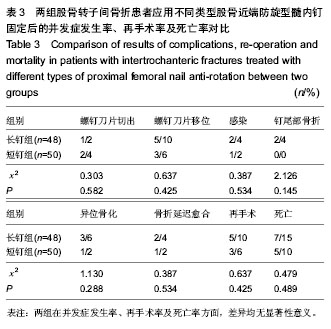
| [1] Matre K, Havelin LI, Gjertsen JE,et al. Intramedullary nails result in more reoperations than sliding hip screws in two-part intertrochanteric fractures.Clin Orthop Relat Res. 2013;471(4): 1379-1386. [2] Lee YK, Chung CY, Park MS,et al.Intramedullary nail versus extramedullary plate fixation for unstable intertrochanteric fractures: decision analysis.Arch Orthop Trauma Surg. 2013; 133(7):961-968. [3] Lee SR, Kim ST, Yoon MG,et al.The stability score of the intramedullary nailed intertrochanteric fractures: stability of nailed fracture and postoperative patient mobilization.Clin Orthop Surg. 2013;5(1):10-8. [4] Gallagher D, Adams B, El-Gendi H,et al.Is distal locking necessary? A biomechanical investigation of intramedullary nailing constructs for intertrochanteric fractures.J Orthop Trauma. 2013;27(7):373-378. [5] Zhu Y, Meili S, Zhang C,et al.Is the lag screw sliding effective in the intramedullary nailing in A1 and A2 AO-OTA intertrochanteric fractures? A prospective study of Sliding and None-sliding lag screw in Gamma-III nail.Scand J Trauma Resusc Emerg Med. 2012;20:60. [6] Radcliff TA, Regan E, Cowper Ripley DC,et al. Increased use of intramedullary nails for intertrochanteric proximal femoral fractures in veterans affairs hospitals: a comparative effectiveness study. J Bone Joint Surg Am. 2012;94(9): 833-840.[7] Kokoroghiannis C, Aktselis I, Deligeorgis A, et al.Evolving concepts of stability and intramedullary fixation of intertrochanteric fractures--a review.Injury. 2012;43(6): 686-693. [8] Ertürer RE, Sönmez MM, Sar? S,et al. Intramedullary osteosynthesis of instable intertrochanteric femur fractures with Profin® nail in elderly patients.Acta Orthop Traumatol Turc. 2012;46(2):107-112. [9] de Grave PW, Tampere T, Byn P,et al. Intramedullary fixation of intertrochanteric hip fractures: a comparison of two implant designs. A prospective randomised clinical trial.Acta Orthop Belg. 2012;78(2):192-198.[10] Haidukewych GJ.Intertrochanteric fractures: ten tips to improve results.Instr Course Lect. 2010;59:503-9.[11] Haidukewych GJ.Intertrochanteric fractures: ten tips to improve results.J Bone Joint Surg Am. 2009;91(3):712-719.[12] 杨沛彦,李耀锋,尤元璋.股骨近端抗旋髓内钉与股骨近端解剖型锁定板治疗不稳定型转子间骨折的疗效比较[J].中华创伤杂志, 2013, 29(4): 330-333.[13] Aprato A, Jayasekera N, Villar RN. Does the modified Harris hip score reflect patient satisfaction after hip arthroscopy. Am J Sports Med. 2012;40(11):2557-2560. [14] Shayesteh-Azar M, Karimi-Nasab MH, Sajjadi-Saravi M,et al.Comparison of surgical complications of intertrochanteric hip fractures between non-osteoporotic and osteoporotic patients.J Pak Med Assoc. 2013;63(6):752-755.[15] Shen L, Zhang Y, Shen Y,et al. Antirotation proximal femoral nail versus dynamic hip screw for intertrochanteric fractures: a meta-analysis of randomized controlled studies.Orthop Traumatol Surg Res. 2013;99(4):377-383. [16] Streubel PN, Moustoukas MJ, Obremskey WT. Mechanical failure after locking plate fixation of unstable intertrochanteric femur fractures.J Orthop Trauma. 2013; 27(1):22-28. [17] Sun B, Li K, Zhu Y,et al. Posterior wall reconstruction using intertrochanteric crest strut graft in comminuted posterior acetabular wall fractures.Hip Int. 2013;23(2):199-203. [18] Talmo CT, Sambaziotis C, Bono JV. Conversion Hemiarthroplasty and Valgus Osteotomy After Failed ORIF of Hip Intertrochanteric Fractures.Orthopedics. 2013;36(9): 693-696. [19] Tao R, Lu Y, Xu H,et al. Internal fixation of intertrochanteric hip fractures: a clinical comparison of two implant designs.ScientificWorldJournal. 2013;2013:834825.[20] Xue L, Zha L, Chen Q,et al. Randomized controlled trials of proximal femoral nail antirotation in lateral decubitus and supine position on treatment of intertrochanteric fractures. ScientificWorldJournal. 2013;2013:276015.[21] Yang YH, Wang YR, Jiang SD,et al. Proximal femoral nail antirotation and third-generation Gamma nail: which is a better device for the treatment of intertrochanteric fractures.Singapore Med J. 2013;54(8):446-450.[22] Huang FT, Lin KC, Yang SW,et al. Comparative study of the proximal femoral nail antirotation versus the reconstruction nail in the treatment of comminuted proximal femoral fracture.Orthopedics. 2012;35(1):e41-47. [23] Gong H, Wang L, Zheng D,et al. The potential application of functionally graded material for proximal femoral nail antirotation device.Med Hypotheses. 2012;79(3):415-417.[24] Frei HC, Hotz T, Cadosch D,et al. Central head perforation, or "cut through," caused by the helical blade of the proximal femoral nail antirotation.J Orthop Trauma. 2012;26(8): e102-107. [25] Fliri L, Lenz M, Boger A,et al. Ex vivo evaluation of the polymerization temperatures during cement augmentation of proximal femoral nail antirotation blades.J Trauma Acute Care Surg. 2012;72(4):1098-1101. [26] Takigami I, Ohnishi K, Ito Y,et al. Acetabular perforation after medial migration of the helical blade through the femoral head after treatment of an unstable trochanteric fracture with proximal femoral nail antirotation (PFNA): a case report.J Orthop Trauma. 2011;25(9):e86-89.[27] Lv C, Fang Y, Liu L,et al.The new proximal femoral nail antirotation-Asia: early results.Orthopedics. 2011;34(5):351. [28] Han N, Sun GX, Li ZC,et al.Comparison of proximal femoral nail antirotation blade and reverse less invasive stabilization system-distal femur systems in the treatment of proximal femoral fractures.Orthop Surg. 2011;3(1):7-13. [29] Garg B, Marimuthu K, Kumar V,et al. Outcome of short proximal femoral nail antirotation and dynamic hip screw for fixation of unstable trochanteric fractures. A randomised prospective comparative trial.Hip Int. 2011;21(5):531-536.[30] Cheung JP, Chan CF.Cutout of proximal femoral nail antirotation resulting from blocking of the gliding mechanism during fracture collapse.J Orthop Trauma. 2011;25(6):e51-55.[31] Xu YZ, Geng DC, Mao HQ,et al. A comparison of the proximal femoral nail antirotation device and dynamic hip screw in the treatment of unstable pertrochanteric fracture.J Int Med Res. 2010;38(4):1266-1275.[32] Xu Y, Geng D, Yang H,et al.Treatment of unstable proximal femoral fractures: comparison of the proximal femoral nail antirotation and gamma nail 3.Orthopedics. 2010;33(7):473.[33] Wang WY, Yang TF, Fang Y,et al.Treatment of subtrochanteric femoral fracture with long proximal femoral nail antirotation. Chin J Traumatol. 2010;13(1):37-41.[34] Wang WY, Liu L, Wang GL,et al.Ipsilateral basicervical femoral neck and shaft fractures treated with long proximal femoral nail antirotation or various plate combinations: comparative study.J Orthop Sci. 2010;15(3):323-330.[35] Tang X, Liu L, Yang TF,et al. Preliminary effect of proximal femoral nail antirotation on emergency treatment of senile patients with intertrochanteric fracture.Chin J Traumatol. 2010;13(4):212-216.[36] Sahin S, Ertürer E, Oztürk I,et al. Radiographic and functional results of osteosynthesis using the proximal femoral nail antirotation (PFNA) in the treatment of unstable intertrochanteric femoral fractures.Acta Orthop Traumatol Turc. 2010;44(2):127-134.[37] Liu Y, Tao R, Liu F,et al. Mid-term outcomes after intramedullary fixation of peritrochanteric femoral fractures using the new proximal femoral nail antirotation (PFNA).Injury. 2010;41(8):810-817. [38] Kristek D, Lovri? I, Kristek J,et al.The proximal femoral nail antirotation (PFNA) in the treatment of proximal femoral fractures.Coll Antropol. 2010;34(3):937-940.[39] Zou J, Xu Y, Yang H.A comparison of proximal femoral nail antirotation and dynamic hip screw devices in trochanteric fractures.J Int Med Res. 2009;37(4):1057-1064.[40] Schmidt-Rohlfing B, Heussen N, Knobe M,et al. Reoperation rate after internal fixation of intertrochanteric femur fractures with the percutaneous compression plate: what are the risk factors. J Orthop Trauma. 2013;27(6):312-317.[41] Rubio-Avila J, Madden K, Simunovic N,et al.Tip to apex distance in femoral intertrochanteric fractures: a systematic review.J Orthop Sci. 2013;18(4):592-598. [42] Pui CM, Bostrom MP, Westrich GH,et al. Increased Complication Rate Following Conversion Total Hip Arthroplasty After Cephalomedullary Fixation For Intertrochanteric Hip Fractures: A Multi-center Study.J Arthroplasty. 2013;28(8 Suppl):45-47.[43] Barton TM, Gleeson R, Topliss C,et al. A comparison of the long gamma nail with the sliding hip screw for the treatment of AO/OTA 31-A2 fractures of the proximal part of the femur: a prospective randomized trial. J Bone Joint Surg Am. 2010; 92(4):792-798.[44] Zhang S, Zhang K, Jia Y,et al. InterTan nail versus Proximal Femoral Nail Antirotation-Asia in the treatment of unstable trochanteric fractures.Orthopedics. 2013;36(3):e288-294.[45] Sahin EK, Imerci A, K?n?k H,et al. Comparison of proximal femoral nail antirotation (PFNA) with AO dynamic condylar screws (DCS) for the treatment for unstable peritrochanteric femoral fractures. Eur J Orthop Surg Traumatol. 2013. [Epub ahead of print][46] Kumbaraci M, Karapinar L, Incesu M,et al. Treatment of bilateral simultaneous subtrochanteric femur fractures with proximal femoral nail antirotation (PFNA) in a patient with osteopetrosis: case report and review of the literature.J Orthop Sci. 2013;18(3):486-489. [47] Huang Y, Zhang C, Luo Y. A comparative biomechanical study of proximal femoral nail (InterTAN) and proximal femoral nail antirotation for intertrochanteric fractures. Int Orthop. 2013. [Epub ahead of print][48] Fensky F, Nüchtern JV, Kolb JP,et al. Cement augmentation of the proximal femoral nail antirotation for the treatment of osteoporotic pertrochanteric fractures--a biomechanical cadaver study.Injury. 2013;44(6):802-807.[49] Zeng C, Wang YR, Wei J,et al.Treatment of trochanteric fractures with proximal femoral nail antirotation or dynamic hip screw systems: a meta-analysis.J Int Med Res. 2012;40(3): 839-851.[50] Wang WY, Yang TF, Liu L,et al. A comparative study of ipsilateral intertrochanteric and femoral shaft fractures treated with long proximal femoral nail antirotation or plate combinations.Orthop Surg. 2012;4(1):41-46.[51] Vaquero J, Munoz J, Prat S,et al. Proximal Femoral Nail Antirotation versus Gamma3 nail for intramedullary nailing of unstable trochanteric fractures. A randomised comparative study. Injury. 2012;43 Suppl 2:S47-54.[52] Bjørgul K, Reikerås O. Outcome after treatment of complications of Gamma nailing: a prospective study of 554 trochanteric fractures.Acta Orthop. 2007;78(2):231-235.[53] Stern R. Are there advances in the treatment of extracapsular hip fractures in the elderly. Injury. 2007;38 Suppl 3:S77-87.[54] Sears BR, Ostrum RF, Litsky AS. A mechanical study of gap motion in cadaveric femurs using short and long supracondylar nails.J Orthop Trauma. 2004;18(6):354-360. |
| [1] | Chen Xinmin, Li Wenbiao, Xiong Kaikai, Xiong Xiaoyan, Zheng Liqin, Li Musheng, Zheng Yongze, Lin Ziling. Type A3.3 femoral intertrochanteric fracture with augmented proximal femoral nail anti-rotation in the elderly: finite element analysis of the optimal amount of bone cement [J]. Chinese Journal of Tissue Engineering Research, 2021, 25(9): 1404-1409. |
| [2] | Chen Junming, Yue Chen, He Peilin, Zhang Juntao, Sun Moyuan, Liu Youwen. Hip arthroplasty versus proximal femoral nail antirotation for intertrochanteric fractures in older adults: a meta-analysis [J]. Chinese Journal of Tissue Engineering Research, 2021, 25(9): 1452-1457. |
| [3] | Zhang Jing, Wang Bin, Lü Xin. Application of anatomic intramedullary nail in tubular bone fractures of limbs: stronger holding force and anti-rotation ability [J]. Chinese Journal of Tissue Engineering Research, 2021, 25(6): 917-922. |
| [4] | Nie Shaobo, Li Jiantao, Sun Jien, Zhao Zhe, Zhao Yanpeng, Zhang Licheng, Tang Peifu. Mechanical stability of medial support nail in treatment of severe osteoporotic intertrochanteric fracture [J]. Chinese Journal of Tissue Engineering Research, 2021, 25(3): 329-333. |
| [5] | Xiang Feifan, Ye Junwu, Zhang Xihai, Ge Jianhua, Tang Lian, Yang Yunkang. Comparison of three different internal fixation methods in treatment of ipsilateral femoral neck and shaft fracture [J]. Chinese Journal of Tissue Engineering Research, 2021, 25(3): 403-408. |
| [6] | Xing Hao, Zhang Yonghong, Wang Dong. Advantages and disadvantages of repairing large-segment bone defect [J]. Chinese Journal of Tissue Engineering Research, 2021, 25(3): 426-430. |
| [7] | Li Yanle, Yue Xiaohua, Wang Pei, Nie Weizhi, Zhang Junwei, Tan Yonghai, Jiang Hongjiang. Intramedullary nail fixation versus plate fixation in the treatment of displaced midshaft clavicular fractures in adults: a meta-analysis [J]. Chinese Journal of Tissue Engineering Research, 2021, 25(3): 471-476. |
| [8] | Liu Chang, Han Shufeng. Interlocking intramedullary nail for proximal femur versus proximal femoral anti-rotation intramedullary nail or proximal femoral anti-rotation intramedullary nail of Asian for intertrochanteric fractures in older adults: a meta-analysis [J]. Chinese Journal of Tissue Engineering Research, 2021, 25(3): 477-485. |
| [9] | Zhang Degang, Liu Dong, Li Peng, Wang Zhaolin, Zhang Kai, Zhang Xinjun. Short-term follow-up of elastic intramedullary nail and plate in the treatment of displaced middle clavicle type B fracture [J]. Chinese Journal of Tissue Engineering Research, 2021, 25(24): 3860-3864. |
| [10] | Han Shichong, Li Chang, Xing Haiyang, Ge Wenlong, Wang Gang . Finite element analysis of two internal fixation methods for treating extra-articular proximal tibial fractures [J]. Chinese Journal of Tissue Engineering Research, 2021, 25(15): 2329-2333. |
| [11] | Mao Guoshu, Zhou Min, Li Xiaoming, Zhou Zihong, Yin Qudong. Effect of the third fragment on the healing of femoral shaft fractures after intramedullary nailing fixation [J]. Chinese Journal of Tissue Engineering Research, 2021, 25(15): 2405-2409. |
| [12] | Xu Xiaopei, Lü Xin. Classification of intertrochanteric fractures with medial wall destruction in elderly patients and recovery of bony support and continuity of the cortical bone [J]. Chinese Journal of Tissue Engineering Research, 2021, 25(14): 2259-2265. |
| [13] | Wang Lei, Qi Rong, Li Jia, Qiu Zhixue, Wang Kai, Suo Nanangxiu. Minimally invasive percutaneous plate osteosynthesis and elastic nail system in the treatment of distal tibiofibular fracture in adults [J]. Chinese Journal of Tissue Engineering Research, 2021, 25(12): 1864-1868. |
| [14] | Zheng Zhihui, Chen Sheng, Guan Keli, Zheng Xun, Chen Haibo, Zeng Qingqiang. Relationship between blood loss of proximal femoral nail anti-rotation fixation and local use combined with intravenous injection of tranexamic acid [J]. Chinese Journal of Tissue Engineering Research, 2020, 24(9): 1359-1364. |
| [15] | Guo Tianqing, Xue Fei, Feng Wei. Internal fixation strategies for different lateral wall types of intertrochanteric fractures of the femur [J]. Chinese Journal of Tissue Engineering Research, 2020, 24(6): 917-923. |
| Viewed | ||||||
|
Full text |
|
|||||
|
Abstract |
|
|||||
